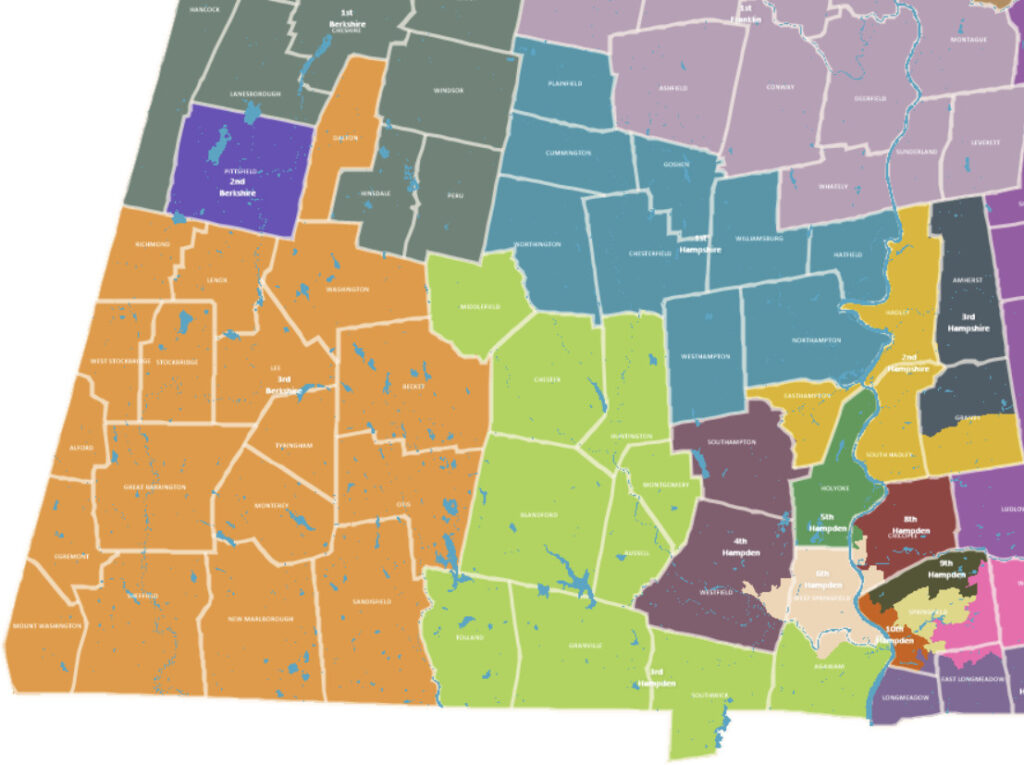Analysis: Why the Berks Race Is Getting Hotter While 2nd Hampshire Idles…

The 3rd Berkshire (orange) may not just be geographically bigger than the 2nd Hampshire (goldenrod). (via Mass. Legislature)
While the open legislative races in the 413 are only a few weeks old, the one in the Berkshires is already proving to be the hotter of the two. Since Easthampton Representative Daniel Carey’s departure to run for Hampshire Clerk of Courts, only one candidate has emerged. By comparison, the seat the region’s legislative dean holds already has two challengers.
There are substantial differences between Carey’s district and that of William “Smitty” Pignatelli who announced his retirement this month. Despite its curlicues and leaps across the Connecticut River, the 2nd Hampshire District is compact, encompassing four communities. By contrast, the 3rd Hampshire reaches across 18 towns. This distinction has implications for how these races may develop.
The Democratic primary will be the real contest in both races. No Republicans have filed with the state yet, but it would be incredibly difficult for the GOP to conquer either of these seats.
A party of two, where the 3rd Berkshire Democratic primary now stands, is hardly the mob that vied for the 1st Franklin back in 2018. However, that race, which the retirement of the late Stephen Kulik prompted, could share more with the race the Berks could potentially enjoy. Although redistricting reconfigured the 1st Franklin considerably, then, as now, it sweeps across multiple small towns.
In the 3rd Berkshire, Stockbridge Select Board member Patrick White and Great Barrington Select Board member Leigh Davis have already filed with state campaign finance regulators. There is still plenty of room for a candidate to emerge from other towns, such as Lenox or neighboring Lee.
Indeed, any town in the district could mint a rep. There is no concentration of population that would necessarily impute a geographic advantage on any candidate. However, White has roots in Lenox and Davis may have some advantages thanks to Great Barrington’s economic and cultural assets.
Another factor that could contribute to the race’s potential is the old curse of politics: money. Berkshire County generally has suffered mightily from deindustrialization. Yet, the southern end of the country, where the district sits, hosts some of the most enduring arts institutions in the country. Its proximity to New York—both the city and Mid-Hudson region—and the rise of remote work have made the southern Berkshires attractive.
Whether such newcomers have the roots to credibly fund or pursue a campaign for state rep remains to be seen. Yet, it is not a factor to discount in the coming months.
Back in the Valley, however, the 2nd Hampshire seems likelier to stay small. Also in 2018, South Hadley Rep John Scibak called it quits. Then-Easthampton Councilor Carey won the ensuing race. The dynamics of that campaign may be setting the tone for this one.

Easthampton Rising above the rest? In 2nd Hampshire anyway… (via wikipedia)
Few would have challenged Scibak, but since his first election, the center of gravity in the district moved away from South Hadley and toward Easthampton. Plus, Easthampton got more Democratic. That meant more Democratic voters in the primary. It was too much for candidates running out of South Hadley and Granby—half of which is in the district— to overcome.
Observers believe a candidate out of Hadley, the fourth town in the district and smaller than South Hadley in population, would fare no better.
The only announced candidate for Carey’s seat is Easthampton City Council president Homar Gomez. In one sense, Gomez is quite a different candidate that Carey was. Carey was an at-large councilor. Gomez only represents one precinct. But more critically, Carey had deep institutional and political support. Nearly everyone in town rallied behind him in the primary.
That said, Gomez can probably channel the provincial desire of Easthampton movers and shakers to hold onto the seat. Anybody interested in an alternative will face a dilemma. Back another person from Easthampton and split its weight in the race. Back somebody out of town who may not have the base to win.
That is not to say that contest will have only one candidate. Nor is it certain that a crowd will run in the Berkshire seat. However, the conditions are there for such scenarios.
Ultimately, what may define both of those races are the issues the candidates center. While the Berkshires have seen some investment from newcomers, longstanding economic headwinds endure. The strains of population decline burden schools and the delivery of services. Such thorny issues will anchor whoever runs.
There is a throughline to the 2nd Hampshire, common to the 413 and indeed much of outstate Massachusetts. Managing municipalities and recruiting staff is a challenge both the Valley and the Berkshires share.
However, Easthampton has seen growth and eyes more. UMass-Amherst and its function have a huge impact on the district. Plus, unlike Mount Holyoke College, also in the district, the university is within state control. Many of the issues that animated Carey’s race for rep will animate the race to replace him.
In both districts, these debates are essential both during the campaigns but also after. Whoever wins must carry them to Beacon Hill lest they face revolt back home later.
1 thoughts on “Analysis: Why the Berks Race Is Getting Hotter While 2nd Hampshire Idles…”
Comments are closed.